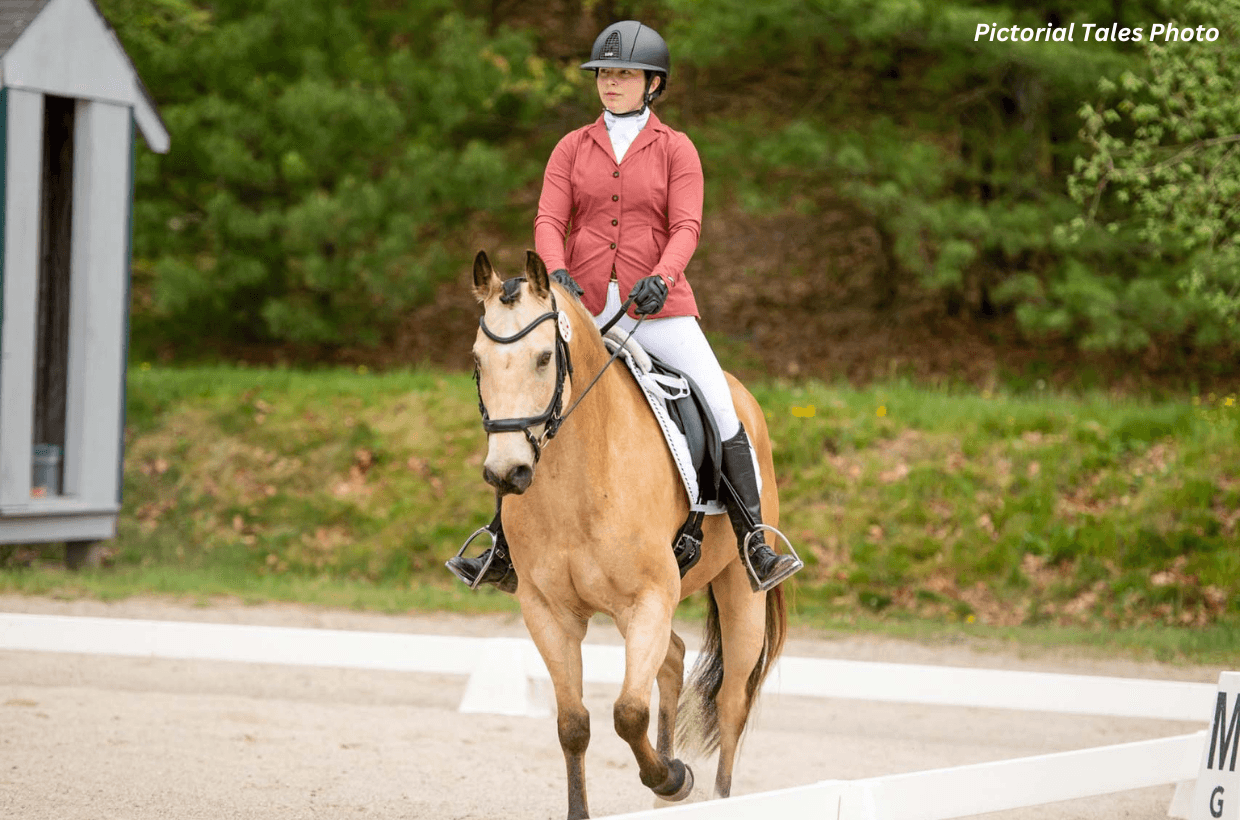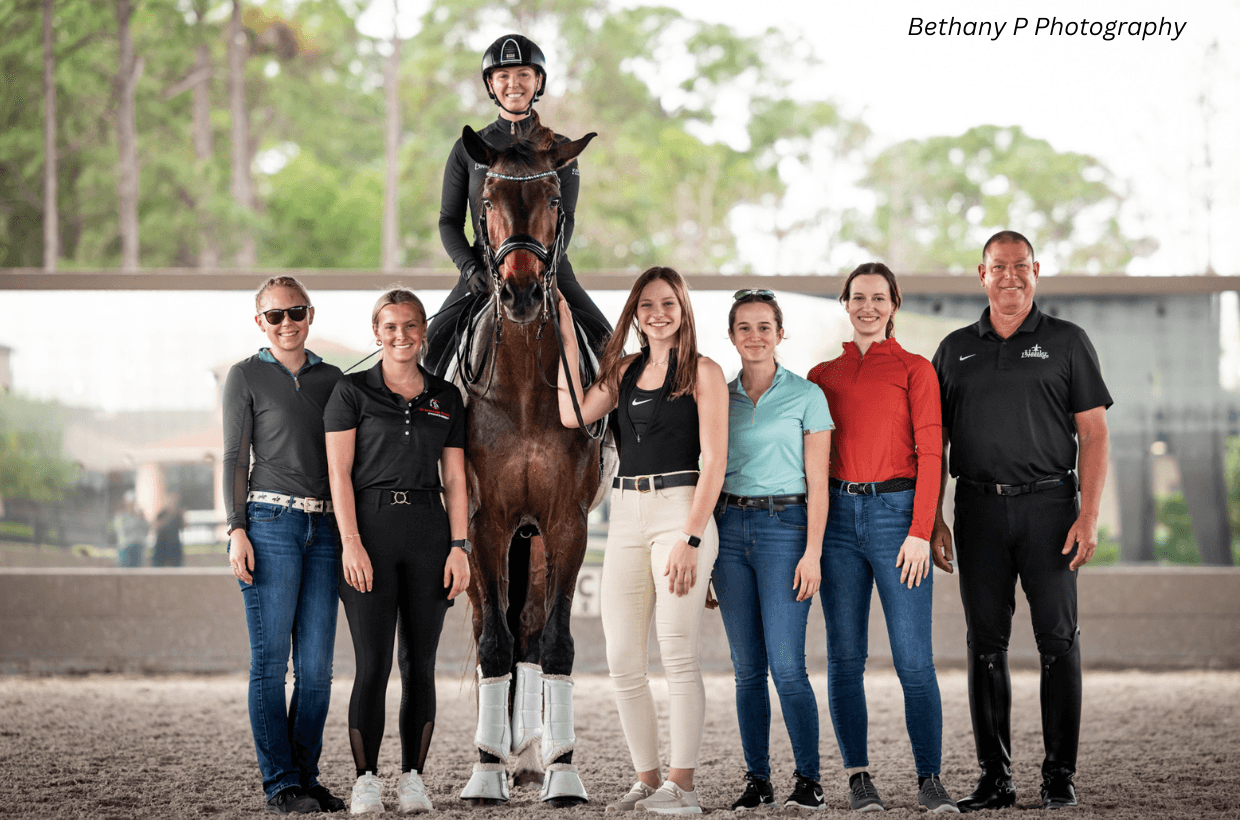2021 Major Anders Lindgren Instructor Grant Recipient: Emma Smith

Photo by Susan J Stickle
At first, I wasn’t quite sure how to write this grant report. This season ended up being very different than I had hoped/planned for it to be and, as such, I couldn’t organize this report as I have in the past. I generally like to write about training tips that I have learned and try to share as much as I have learned as possible so that others can have the experience that The Dressage Foundation has been so generous to make possible for me. However, this year felt different. It’s not that I didn’t learn things – because I did. I learned a ton. However, I was having trouble pulling together a list of exercises or metaphors that really stuck with me. So, I am going to try to just write what I took away from this winter overall. Hopefully, it will be insightful and helpful for people.
When I got down to Florida, my horse Stedemann was recovering from a bad joint flare in reaction to a joint injection in August. We had qualified for our first Brentina Cup and done some routine injections that he was due for ahead of the show. Five days later, he was in the hospital. We had a great team of vets helping him, from the vets at the University of Minnesota to our vet, Cricket Russillo, in Florida, who was consulting and helping in any way she could. He was recovering well but it was taking some time. When we got down to Florida, he was just building up strength after having so much time off. When it looked like he was ready to go back into more normal work, I had Cricket come out and give him a once over to make sure he was in good shape. He has always been a complicated horse to keep healthy and sound. He was given to me as a donation horse through Dressage4Kids’ amazing horse donation program. That program has been such a blessing and I am so grateful for all the opportunities being paired with Stedemann has opened for me, but the physical problems that caused him to be donated have been something that has challenged us throughout our time together. He was due to have his hocks done and we decided to do that, to make sure he was as comfortable as possible behind and so he wouldn’t have any reason to put extra weight on his front legs. We did a Cushing’s test to make sure that still looked good (as he is getting older) and it all looked good, so we injected his hocks. Five days later, he had a laminitis episode. He started drinking and peeing a lot about 24 hours before things got bad. Then, after his first light ride going back to work, I noticed he wasn’t standing quite right and immediately called Cricket. Thankfully, we were able to get Banamine and treatment into him about 30 minutes after he showed his first signs of discomfort, so we were able to treat him very quickly, but it was a long process.
I count myself, and Stedemann, incredibly lucky with his laminitis episode. He recovered well and doesn’t have any lasting effects. However, he was completely off for about a month, and then we slowly started to build back into work again. At that point, I really thought our season in Florida was shot. However, Stedemann surprised me again (as he has many times before) with his ability to bounce back and get back into the groove of things quickly, all things considered. It was great that this was our second season at the U25, so while there was (and still is) plenty to work on, we both knew our jobs. Once I was able to build up a baseline level of fitness with him, we were able to get in some lessons with Olivia Lagoy-Weltz (whose barn I was in for the season for training and working as a working student) and did a qualifier for Festival of Champions at Lamplight our last weekend in Florida in the middle of April. The qualifier didn’t go as well as I had hoped. We had a lot of dust to brush off after not being in the ring since July. But after everything Stedemann had been through this season, it was a privilege to be able to get back in the ring with him at all.
I do have some training tips and horse care tips that I will lay out at the end of this report. However, as I was reflecting on this season, I realized that, while those are incredibly valuable, they weren’t my biggest takeaway. My parents always joke that they never should have let me start riding horses. The amount of time, energy, and money that goes into this sport are astronomical. However, this season was, in my mind, a great example of why, if I ever have children, I would love for them to ride. I am by no means a perfect person nor am I done growing as a person, but horses have taught me perseverance, humility, patience, and the importance of hard work. They have shown me that you can do everything right and to the best of your abilities, and things can still go wrong. Life isn’t fair. But there is joy in the process, and you learn something from every experience, good or bad. I would guess that over 50% of the time I have had Stedemann - almost six years now - has been spent rehabbing him from various injuries. Even when he is in full work, the amount of maintenance and care that he requires to keep him happy and healthy in his work is more than I have ever put into a horse before. He has taught me patience and perseverance during the hours of hand walking, icing, lasering, massaging, etc. while on stall rest and while in work. He has taught me hard work because, it doesn’t matter whether I am tired, cold, disappointed, or anything else, I must go and take care of him and give him what he needs. In exchange, he is always there to stick his tongue out for a treat or obnoxiously play with my ponytail every time I try to walk him somewhere. As a trainer, I am teaching kids and adults to ride. But, especially with my younger clients, I am also using the experience of working with horses to help them grow as people.
About a year after I got Stedemann, after spending that time trying to figure out what was wrong with him and how to get him healthy, I had finally saved up enough money to just take him in for an MRI and hopefully get to the bottom of the issues. After we got the results back, the vet sat me down and said that he would never be more than a trail horse. It would be in my best interest to retire him. My trainer and the clinician we were working with at the time also said the same thing. However, being 19 and stubborn I decided to try to rehab him. It took two years but, not only did he come back to FEI work, he has surpassed what he was doing before and is showing in the U25 and getting ready for our first senior Grand Prix this summer.
This winter wasn’t what I had hoped. I had hoped to get a lot of help from Olivia leveling up our U25 tests and getting some qualifiers done. I had hoped we would be able to put some finishing touches on the senior Grand Prix test we had been working on and show that to complete a dream of mine since I was five years old. However, while I didn’t accomplish all I wanted to competitively and training-wise with Stedemann this season, it reminded me how lucky I am to be able to do anything at all with Stedemann. He could have been retired at 13 as was recommended, but now he is happy, healthy, and sounder than ever at 18 and getting ready for both of our first Grand Prix. We just got home from a show in Chicago at the end of May where we put in the two most solid Grand Prix freestyle tests we have done. It made me appreciate all this sport has given me and how lucky I am to get to have a horse like Stedemann in my life. I am so grateful to TDF for awarding me this grant. I wouldn’t have been able to make this season happen without it and, while it wasn’t what I had hoped before we got down there, I learned a lot and it set us up to be in a great position going forward with our show season this summer. Hopefully, you will see Stedemann and me at the Festival in August with our USDF gold medal under our belts!
While I didn’t get as many lessons with Olivia as I had hoped, Olivia is an amazingly gifted teacher, and I learned a ton in a couple of weeks of lessons I was able to take. Here are some of the main takeaways from my lessons with Olivia, and some of the main horse care tips I picked up working in her barn with her, her amazing assistant Nicole, and her whole team:
- One of the main things we worked on with Stedemann was starting to develop a more upper-level frame. I can pick him up and he has scored well in the FEI work, but I prefer to really feel like he is stretching into the contact and lifted through his back. While those are important things to maintain throughout the training, Olivia worked with me on the fact that a good Grand Prix frame is going to feel different than a good Third Level frame. It is not that you want them to lose the connection through their neck and back - that is essential - but it is going to change so that they have more room to bring their hind legs underneath them and push up through their shoulders. Olivia talked a lot about having the feeling of Stedemann’s body shaping itself like one of those ancient Chinese wooden horses. While this isn’t the right visual for all horses, it worked for Stedemann because he has such a flat back and doesn’t have the tendency to drop his back under the saddle. Also, this shape didn’t feel very good at first. For the first couple of weeks, we worked on it, he felt very braced and stiff, and I felt like I lost some access to his back. However, he has just had to build some new muscles and I have had to get used to it. Pushing through that spot and continuing to work on it even though it didn’t feel good has made us start to come out the other side with an even better balance than we had before.
- We also worked a lot on the one tempi change. Those are a highlight for us at home, but I have never been able to consistently get them in the ring. We worked a lot on the adjustability and repeatability of the changes. Normally, if I could get a good line or two at home, I would leave it. However, when Olivia pressed me to do them again, we found that I generally couldn’t, especially if we left them and then came back to them later in the ride. We worked a lot on always having the one tempi’s available to us. Also, I had the feeling that once I started the ones, I was set. They have been so easy at home since he learned them so that was usually good enough. However, at the show, where they are harder, I need to be able to talk to him and move him during the line to help him when he starts to lose his balance or tighten up. We did a varying number of ones in combination with a couple of strides in the middle to make sure he stays with me. I always worked on being able to move the line and have built up to doing the curved lines so that I am able to move each part of his body in the ones.
This weekend, we got all of our one tempi’s in the ring for the first time! We had no mistakes in the warm-up or show ring all weekend.
- At the show, we worked a lot on our warm-up. We have gone through many different variations of warmups with Stedemann over the years. He is a bit of a diesel truck (slow to warm up) and always has been. However, how we get him to a better place has varied. Stedemann has kind of figured out that I can’t correct him as much in the ring, so he got in a bit of a habit of quitting on me in the ring. Olivia really had me work on calling him up to the plate in the warm-up so that he knows that I mean business. Then, when I went into the ring and was going around before the bell, she had me do the same thing so that he knows that nothing has changed, and the same level of work is required from him in the ring as in the warm-up.
I also wanted to write something I picked up with one of my other horses in Florida. He was not involved in the grant, so the money didn’t go towards his expenses. However, the grant was one of the reasons I was able to be in Florida at all, so I figure what I learned about him is also due to the grant! I have a horse who has been struggling with his flying changes for years. He has a good canter but moved around a lot when he was younger and seems to have just gotten confused. Olivia was helping me with his changes a few years ago, but then he got hurt in the field and needed two years off. We have started again, and Olivia helped me make an incredible amount of progress on his changes this year. My two main takeaways from working on his changes with Olivia were:
- When a horse is learning changes, the setup for what will make a successful change will always be changing. For example, one week I would need to send him fairly forward and really push him into my new outside rein to get the changes clean, and then a couple of days later I would need to bring it back and keep him fairly straight to get a clean change. Olivia was really good about helping me to figure out where he was at each day. Just because something was working in the past doesn’t mean it was the best setup for that day, so I had to adjust with him. Don’t be afraid to try new things if something isn’t working.
- I really wanted to get the single changes perfect and clean before I started stringing them together. While of course, the single changes must be solid before you start lines (even without a count), Olivia showed me that stringing changes together can be a tool, and learning changes isn’t a linear process. Starting to string changes together can be very helpful in teaching the horse and rider to keep themselves organized both during and after the change. If the horse learns another change could be coming right away, some horses will respond by keeping themselves more organized and in control in those crucial strides after the change.
Fungus was especially bad in Florida this year. One of the best tips I got for fungus came from Laura Schneider, who worked with us on Mondays. She said to put Ascend on the fungus and then do a sweat with Saran wrap for 12-24 hours. Then I could wash their legs. That way the scabs just fall off and you don’t have to pick at things or cause any more discomfort or irritation. It was so helpful! Also, one of the most important things is just keeping legs clipped. The fungus loves living under long hair, so the shorter I kept the hair on their legs the better.
If you ever have a horse get steroid injections, and they start to drink or pee more than usual - even if it isn’t significant - you should keep an eye on that. That was the first sign that Stedemann was trying to flush something from his system and was having trouble. We noticed that, of course, but didn’t realize how specific a symptom that could be RE an impending laminitic episode (when the horse has just had a dose of steroids).









